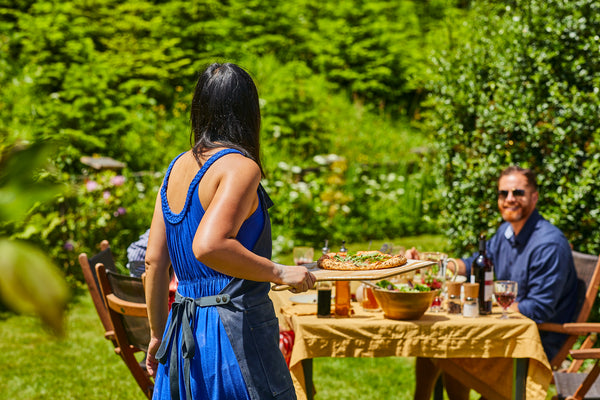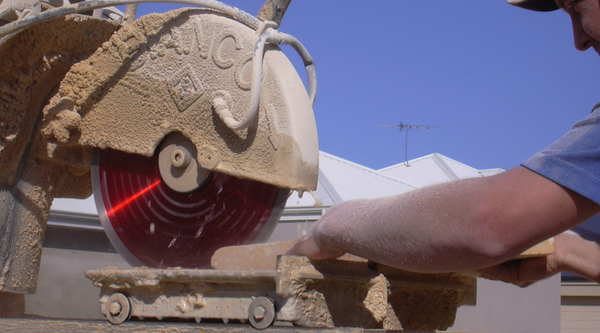
How about concrete a benchtop?
Making benchtops from concrete? Yes, sounds a little strange to some maybe. Not the kind of material that you would think of when selecting a benchtop. Hey but it's a great choice! It's durable, reasonably cheap and quite easy to make, plus, it looks great when finished! There's just no limit to your creativity.
Concrete benchtops are becoming increasingly popular in outdoor areas and boutique kitchens. They can be customized to fit any area, giving an industrial chic look that is both sophisticated and stylish. But to get the perfect finish, you will need to polish the concrete. Here's a guide on how to do just that.
Firstly, you'll need to make a mould for the concrete. Melamine boards or chipboards with a very smooth finish would be ideal to use to construct the mould. The mould can be in any shape or size, but keep in mind that the weight of the finished piece has got to be light enough for two people to carry. So, it is best to limit each section to a weight that two people can lift comfortably, but don’t make the mistake of making it too thin.
For rounded corners used a piece of flexible Perspex at each corner and you can also include cut-outs for taps and sinks using sections of PVC pipes etc. Once the foundation is set, screw the melamine together, leaving each screw approximately 200mm apart, making sure all of the screw heads are accessible from the outside the mould as you'll need to unscrew them later. Tape over the screw head to avoid it being filled by concrete slurry, as this will make it difficult to remove.
Firstly, you'll need to make a mould for the concrete. Melamine boards or chipboards with a very smooth finish would be ideal to use to construct the mould. The mould can be in any shape or size, but keep in mind that the weight of the finished piece has got to be light enough for two people to carry. So, it is best to limit each section to a weight that two people can lift comfortably, but don’t make the mistake of making it too thin.
For rounded corners used a piece of flexible Perspex at each corner and you can also include cut-outs for taps and sinks using sections of PVC pipes etc. Once the foundation is set, screw the melamine together, leaving each screw approximately 200mm apart, making sure all of the screw heads are accessible from the outside the mould as you'll need to unscrew them later. Tape over the screw head to avoid it being filled by concrete slurry, as this will make it difficult to remove.

Keep the moulds at a minimum 45mm deep, as any thinner, the benchtops would crack. As concrete has quite poor tensile strength, it needs to be reinforced using steel reinforcing bars (re- bars) Use a 6mm rebar to form around the edge and also form a grid (Welded Mesh) in the centre. Wire it together and suspend it within the mould with wire hangers. This stops it sinking to the base when concrete is poured in, so the rebar needs to be at the top of the mould or the bottom of the finished piece when finished.
Once the mould is set up, mix the concrete (in a mixer if possible, as it will always going to give you the best mix), making sure the components are well combined. You may add in colour pigments to a standard concrete mix to match your decor. You can also play with different types of stones to achieve a look you want.

Pour or shovel in the concrete when ready and using a Magnesium float, push the concrete into the edges of the mould. Use a hammer to tap the mould all around to help rid off any air pockets which would create voids in the surface. A palm sander works well for this too. This makes it vibrate the bubbles out. Now screed off the surface with a straight edge. You will then need to make the surface smooth with a pointed finishing trowel. This will make your job easier for the next step.
Make sure your moulds are left to cure on a completely flat surface as the weight of the concrete will bend the moulds to fit the surface you placed them on. Leave them to cure for at least 4 days without moving it.
After four days, carefully remove the melamine boards/chipboard edges, the concrete will still be weak and will easily damage, so if you are concerned about chipping the edges, then leave it to cure for a longer period. Concrete reaches 90% of it's finished strength in about 30 days unless you use hardener which will also shorten your working time.

Carefully tap the edges of the base until it freely comes away from the concrete. You can then carefully turn the piece over.
Now you will need specialist tools to polish the concrete. Once you have all of your tools gathered together, it's time to begin polishing your concrete benchtop! Begin by making sure the surface is completely dry before starting so that no dust particles interferes with your work. Polishing will expose the stone from the concrete mix. Use a hand held wet grinder/polisher with a variable speed adjustment and use various grades of the polishing pad.
First, use a diamond cup wheel to remove one or two millimetres of the surface of the concrete to expose the aggregates. Now using a rigid backing pad, utilise a further 5 - 7 grades of white face resin polishing pads to complete. Gradually move up in grit size from 50 – 3000 until you've achieved a desirable level of shine and polish – depending on how glossy you want your finished product to be. This will produce a nice smooth finish. The finer grades will eventually provide a gloss/glass like finish.
Once finished, leave it to dry out for a while before sealing it with a suitable stain repellent impregnator. This also acts as a densifier which hardens the slurry slightly to prevent it powdering or chipping away over time.
This should give you an awesome talking point in any area you will congregate in with friends and family, add some LED lights underneath for added flair.
Your newly polished concrete benchtop will look stunning in whatever space it's placed in and is sure to turn heads with its sophisticated shine!
Polishing a concrete benchtop may seem intimidating at first but once you have the right tools and follow our step-by-step instructions, it's actually quite easy!
Not only can polished concrete look great indoors but also outdoors as well - adding an elegant touch of sophistication wherever it goes! So why not give it a try today? With some patience and effort, there's no doubt that you'll be amazed at how beautiful polished concrete looks after completing this project yourself! Good luck!


